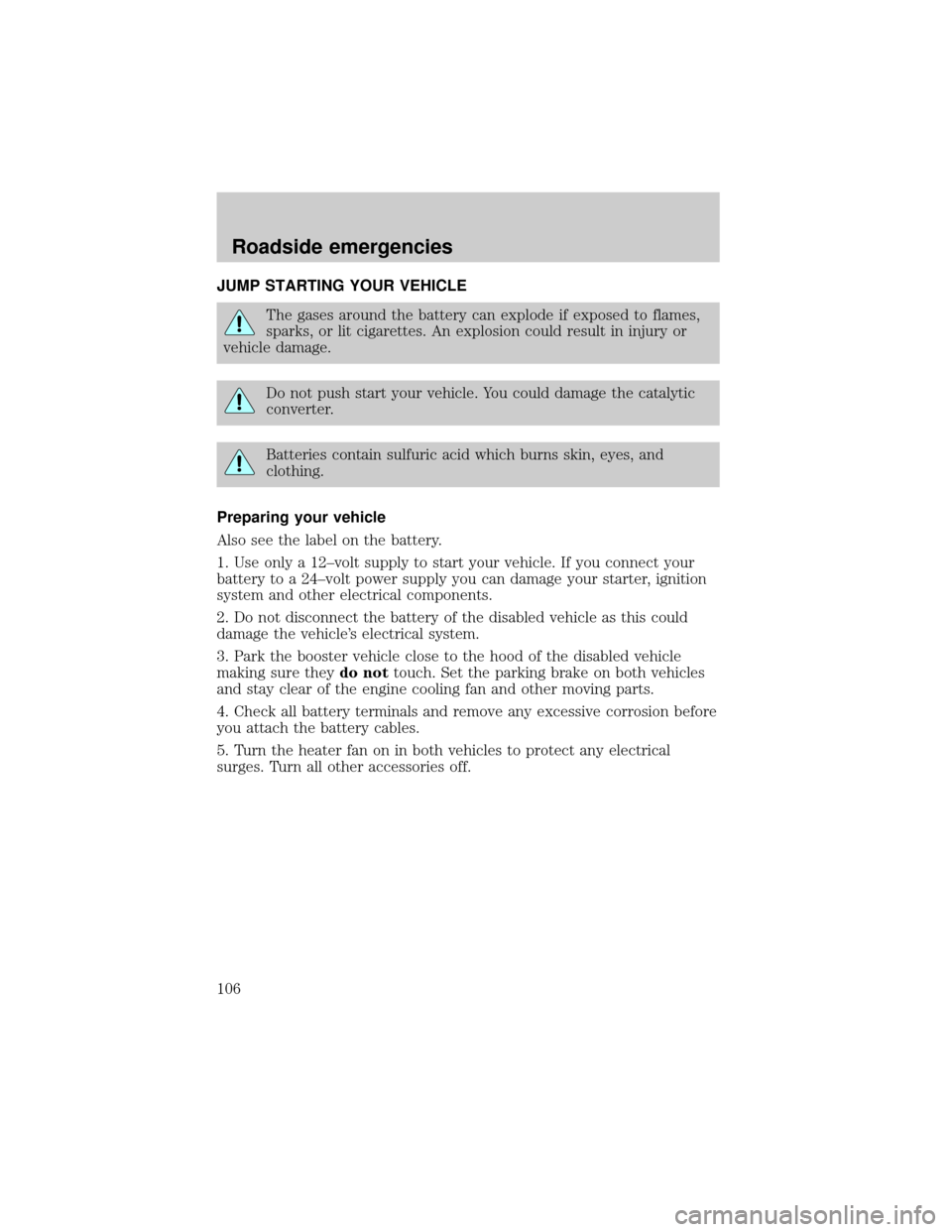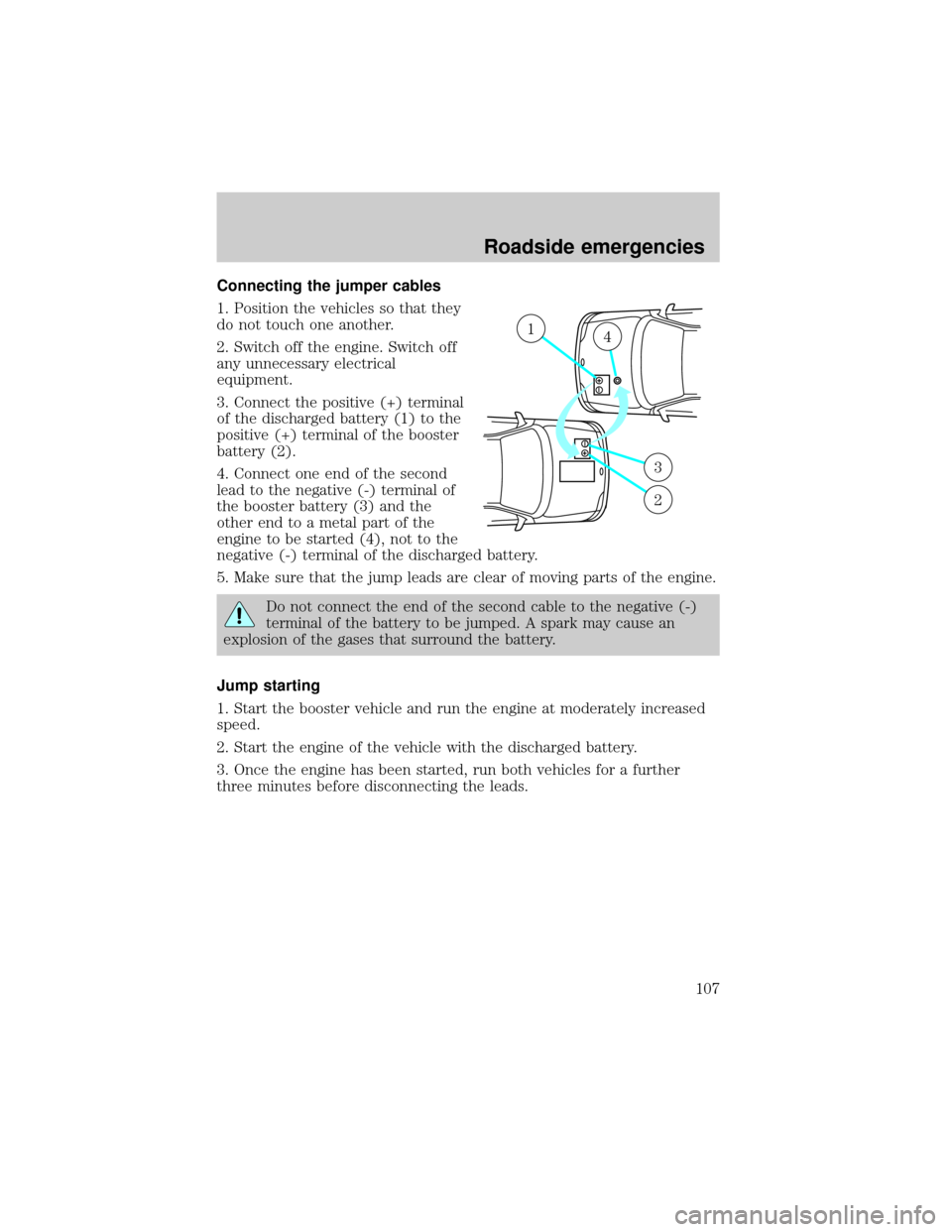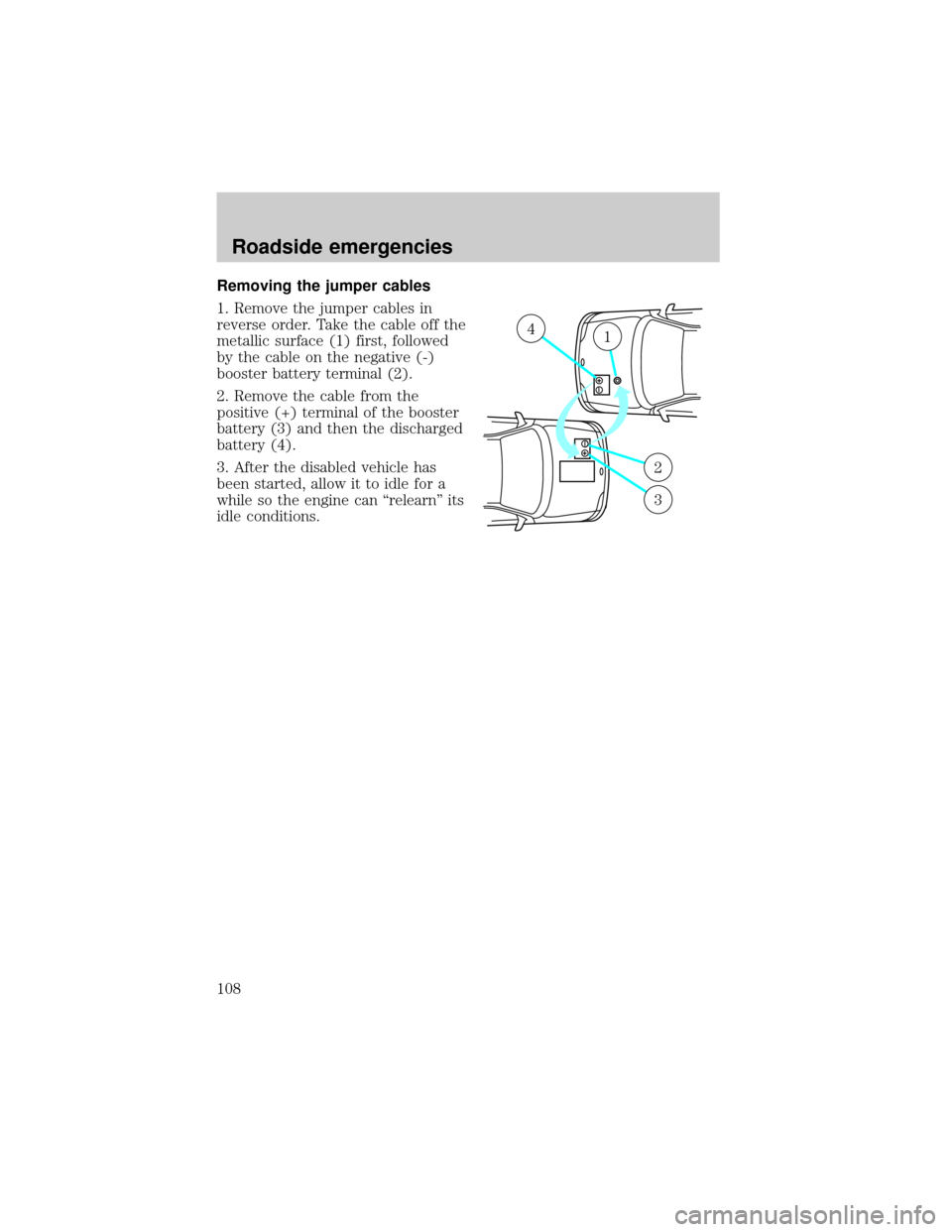jump start FORD RANGER 1998 2.G Owners Manual
[x] Cancel search | Manufacturer: FORD, Model Year: 1998, Model line: RANGER, Model: FORD RANGER 1998 2.GPages: 160, PDF Size: 1.38 MB
Page 106 of 160

JUMP STARTING YOUR VEHICLE
The gases around the battery can explode if exposed to flames,
sparks, or lit cigarettes. An explosion could result in injury or
vehicle damage.
Do not push start your vehicle. You could damage the catalytic
converter.
Batteries contain sulfuric acid which burns skin, eyes, and
clothing.
Preparing your vehicle
Also see the label on the battery.
1. Use only a 12±volt supply to start your vehicle. If you connect your
battery to a 24±volt power supply you can damage your starter, ignition
system and other electrical components.
2. Do not disconnect the battery of the disabled vehicle as this could
damage the vehicle's electrical system.
3. Park the booster vehicle close to the hood of the disabled vehicle
making sure theydo nottouch. Set the parking brake on both vehicles
and stay clear of the engine cooling fan and other moving parts.
4. Check all battery terminals and remove any excessive corrosion before
you attach the battery cables.
5. Turn the heater fan on in both vehicles to protect any electrical
surges. Turn all other accessories off.
Roadside emergencies
106
Page 107 of 160

Connecting the jumper cables
1. Position the vehicles so that they
do not touch one another.
2. Switch off the engine. Switch off
any unnecessary electrical
equipment.
3. Connect the positive (+) terminal
of the discharged battery (1) to the
positive (+) terminal of the booster
battery (2).
4. Connect one end of the second
lead to the negative (-) terminal of
the booster battery (3) and the
other end to a metal part of the
engine to be started (4), not to the
negative (-) terminal of the discharged battery.
5. Make sure that the jump leads are clear of moving parts of the engine.
Do not connect the end of the second cable to the negative (-)
terminal of the battery to be jumped. A spark may cause an
explosion of the gases that surround the battery.
Jump starting
1. Start the booster vehicle and run the engine at moderately increased
speed.
2. Start the engine of the vehicle with the discharged battery.
3. Once the engine has been started, run both vehicles for a further
three minutes before disconnecting the leads.
+–
+–
14
3
2
Roadside emergencies
107
Page 108 of 160

Removing the jumper cables
1. Remove the jumper cables in
reverse order. Take the cable off the
metallic surface (1) first, followed
by the cable on the negative (-)
booster battery terminal (2).
2. Remove the cable from the
positive (+) terminal of the booster
battery (3) and then the discharged
battery (4).
3. After the disabled vehicle has
been started, allow it to idle for a
while so the engine can ªrelearnº its
idle conditions.
+–
+–
41
2
3
Roadside emergencies
108
Page 157 of 160

Hazard flashers ...........................93
Headlamps ...................................16
daytime running lights .............16
flashing ......................................17
high beam .................................16
Heating ........................................17
High beams
indicator light .............................9
Hood ..........................................111
Instrument panel
lighting up panel and interior .17
Jump-starting your vehicle .....106,
107
attaching cables ......................107
disconnecting cables ..............108
Keys
key in ignition chime ...............11
Lamps
interior lamps .........................141
Lights, warning and indicator
air bag ..........................................8
anti-lock brakes (ABS) ..............8
anti-theft .....................................9
brake ............................................8
charging system ..........................9
check engine ............................6,7
cruise indicator .........................10
door ajar ....................................10
fuel reset .....................................8
overdrive off ................................9
safety belt ...................................8
turn signal indicator ...................9
Load limits
trailer towing ............................81
Lubricant specifications ...........150
Manual transmission
driving .............................72,73,74
Mirrors
cleaning ...................................146
side view mirrors (power) .......31
Motorcraft parts ........................147
Odometer .....................................14Off road driving, 4-wheel drive .77
Overdrive .....................................28
Panic alarm feature, remote
entry system ................................33
Parking brake ..............................66
Power door locks ........................31
Power steering
fluid, checking and adding ....123
Radio ............................................24
Recreational towing, all wheels
on the ground .............................89
Refill capacities for fluids ........148
Relays ..........................................94
Remote entry system .................32
illuminated entry ......................34
locking/unlocking doors ...........32
replacement/additional
transmitters ...............................34
replacing the batteries .............33
Reporting safety defects ..........155
Safety restraints
extension assembly ..................45
lap and shoulder belts ...40,41,42
maintenance ..............................46
proper use .................................39
warning light and chime .........11,
45,46
Safety seats for children
attaching with tether straps ....57
tether anchorage hardware .....58
Seats ............................................37
adjusting the seat, manual .......37
jump seats ............................38,39
lumbar support .........................38
rear seat access ........................38
Servicing your vehicle ..............110
precautions when servicing ...110
Snowplowing .................................2
Special notice
diesel-powered vehicles .............3
utility-type vehicles ....................2
Speed control ..............................24
Index
157